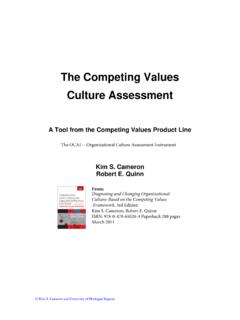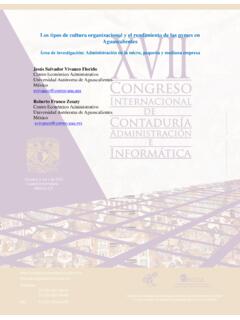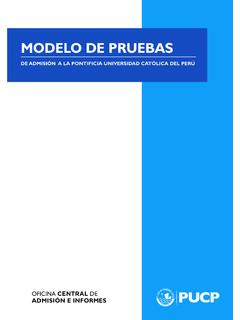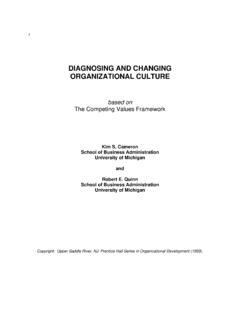Transcription of Report Organizational Culture Assessment ... - OCAI online
1 Report Organizational CultureAssessment InstrumentCompanyXJune 21, 20192 2019 OCAI onlineTable of ContentsThe Organizational Culture Assessment Instrument (OCAI) Introduction 4 The Competing Values Framework 4 The Culture types 6 The OCAI Assessment 8 Working with your OCAI Culture profile 9 Results CompanyX 12 The dominant Culture 12 Discrepancy between current and preferred Culture 13 Cultural Congruence
2 13 Dominant Characteristics 15 Organizational Leadership 16 Management of Employees 17 Organization Glue 18 Strategic Emphases 19 Criteria of Success 20 Congruence 21 Results Demographic1 22 The dominant Culture 22 Discrepancy between current and preferred Culture 23 Six aspects of Culture 24 Congruence 30 Results Demographic2 31 The dominant Culture 31 Discrepancy between current and preferred Culture
3 32 Six aspects of Culture 33 Congruence 39 Results Demographic3 40 The dominant Culture 40 Discrepancy between current and preferred Culture 41 Six aspects of Culture 42 Congruence 483 2019 OCAI onlineResults Demographic4 49 The dominant Culture 49 Discrepancy between current and preferred Culture 50 Six aspects of Culture 51 Congruence 57 Comparison of the results 58 Next steps.
4 OCAI Workshop and the Culture process 61 How to stimulate the Create / Adhocracy Culture 62 How to stimulate the Collaborate / Clan Culture 63 How to stimulate the Control / Hierarchy Culture 63 How to stimulate the Compete / Market Culture 64 Appendix: OCAI-questionnaire 664 2019 OCAI onlineTOCThe Organizational Culture Assessment Instrument (OCAI) IntroductionWelcome to this Report with your Culture Profiles! Please read this Introduction as it will help you understand and work with your influences Organizational performance, innovation, agility, engagement, and competitiveness. Research shows that a toxic Culture decreases productivity with 40%, while an effective Culture increases productivity with 20%, and a positive Culture even with 30-40%.
5 Your OCAI Culture profiles are an insightful start to developing your Organizational Organizational Culture Assessment Instrument (OCAI, Kim Cameron) is a validated tool for assessing Organizational Culture , developed by Robert Quinn and Kim Cameron at the University of Michigan. It is based on the Competing Values Framework: one of the most useful frameworks in business and used by over 10,000 companies in 30 years (ten Have, 2003). The Competing Values Framework (CVF) is validated by the research of Denison, 1990; Howard, 1998; Deshpande & Farley, 2004. It corresponds with other dimensions that describe how people behave when organizing (Linnenluecke, 2010; Ralston, Tong, Terpstra, Wang & Egri, 2006; Cameron & Quinn, 2006). It aligns with the biological drives in the brain: the need to bond, to learn, to acquire, and to defend.
6 (Paul Lawrence, Nitin Nohria, 2002). The CVF can also be related to the Big Five personality traits, the MBTI, and the four psychological types discovered by Carl Gustav Competing Values Framework consists of four Competing Value sets that correspond with four types of Organizational Culture . Every organization has a unique mix of the four Culture types. Quinn and Cameron s extensive research showed that most organizations develop a dominant Culture . The OCAI is a well-researched and validated Culture Assessment , but also compact with six aspects that reliably represent an organization s Competing Values Framework The CVF emerged from research to identify the Organizational effectiveness criteria 5 2019 OCAI onlineTOC(Quinn & Rohrbaugh, 1981). The criteria that were found to make a difference are the dimensions internal-external, and organization might have an internal orientation; focusing inward on development, collaboration, integration of activities, coordination.
7 The opposite is an external orientation; looking at the market, what s possible with the latest technology, what competitors are doing, what customers want, and it could diversify activities as a result. Both internal and external attention is needed to be successful in the long run - but depending on their environment an organization will have a dominant preference. An active, volatile market calls for an external orientation whereas a stable environment allows an internal second defining dimension is the focus on stability or flexibility organizations that prefer stability value clear structures, planning, budgets, and reliability. Organiza-tions that value flexibility, strive to adapt quickly to changing circumstances - focusing more on people and activities than on structure, procedures, and plans. Note the competing nature of the values: organizations focus on the inside or the outside - but cannot do both at the same time.
8 The same goes for stability and flexibility. Organizations can spend their money, attention, and time only once, so they tend to emphasize one value set over the other. However, Quinn and Cameron found that the most effective organizations use all four value sets when necessary and they can show contradictory behavior. Most organizations however have a focused repertory of values and behaviors and a dominant Culture is the best Culture type for your organization? A Culture type works best in the activities domain that aligns with its values. In the health care sector, for instance, we often see Collaborate or Clan Culture . However: there is no ultimate best Organizational Culture prescribed by the Competing Values Framework. The model is descriptive, not normative!In a specific domain or market, one Culture type might fit better than another, and this is for the organization to decide.
9 When would be at our best - given our clients, our employees, our challenges, our resources? This is an important question to answer when you work with your OCAI Profile. (Read more below).1020304050 ClanAdhocracyHierarchyMarketFlexibility and discretionStability and controlExternal focus and differentiationInternal focus and integration6 2019 OCAI onlineTOCThe Culture typesThe two dimensions of competing values combined create four Culture types: the dynamic, entrepreneurial Create Culture , the people-oriented, friendly Collaborate Culture , the process-oriented, structured Control Culture and the results-oriented, competitive Compete Culture . Also known as Adhocracy, Clan, Hierarchy and Market Culture (Cameron & Quinn). The Create / Adhocracy CultureA dynamic, entrepreneurial, and creative place to work. The leaders are considered innovators and risk takers, and so are employees.
10 They share a commitment to experi-mentation and innovation. Prominence is emphasized. The long-term goal is to grow and create new resources. The availability of new products or services is seen as a success. The organization values individual initiative and examples in sectors like start-ups, technology-driven industries (communica-tions, sustainability), and services like Airbnb, Type: innovator, entrepreneur, Drivers: innovative outputs, transformation, for Effectiveness: innovativeness, vision, and new resources produce Strategies: surprise and delight, create new standards, anticipate needs, continuous improvement, find creative solutions, fail fast forward .7 2019 OCAI onlineTOCThe Collaborate / Clan CultureThis working environment is friendly. People have a lot in common, and it feels like a large family. The leaders are seen as mentors or maybe even father figures.





